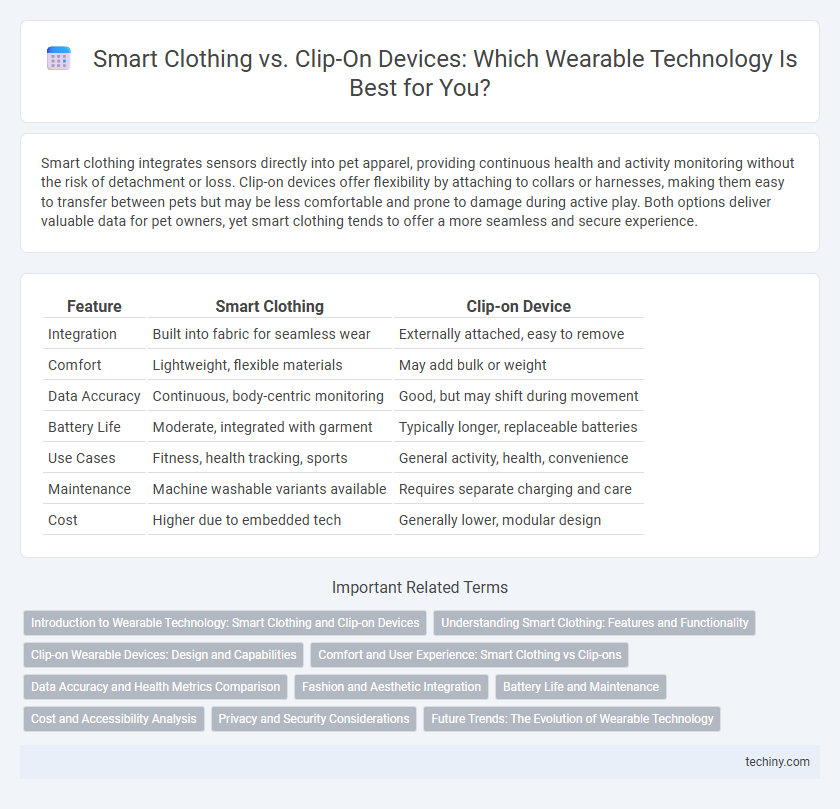Smart clothing integrates sensors directly into pet apparel, providing continuous health and activity monitoring without the risk of detachment or loss. Clip-on devices offer flexibility by attaching to collars or harnesses, making them easy to transfer between pets but may be less comfortable and prone to damage during active play. Both options deliver valuable data for pet owners, yet smart clothing tends to offer a more seamless and secure experience.
Table of Comparison
| Feature | Smart Clothing | Clip-on Device |
|---|---|---|
| Integration | Built into fabric for seamless wear | Externally attached, easy to remove |
| Comfort | Lightweight, flexible materials | May add bulk or weight |
| Data Accuracy | Continuous, body-centric monitoring | Good, but may shift during movement |
| Battery Life | Moderate, integrated with garment | Typically longer, replaceable batteries |
| Use Cases | Fitness, health tracking, sports | General activity, health, convenience |
| Maintenance | Machine washable variants available | Requires separate charging and care |
| Cost | Higher due to embedded tech | Generally lower, modular design |
Introduction to Wearable Technology: Smart Clothing and Clip-on Devices
Wearable technology integrates advanced sensors and connectivity to monitor health, fitness, and environmental data in real time. Smart clothing embeds these technologies directly into textiles for seamless data collection, while clip-on devices offer modular, easily attachable options for similar functionalities. Both approaches enhance user experience by providing personalized insights through continuous, unobtrusive monitoring.
Understanding Smart Clothing: Features and Functionality
Smart clothing integrates sensors and conductive fibers directly into the fabric, enabling continuous biometric monitoring, environmental sensing, and seamless data transmission without external devices. These garments offer real-time health analytics and adaptive comfort through embedded technology, enhancing user experience compared to traditional clip-on devices that rely on attachment and manual synchronization. Advanced features like flexible circuitry and washable components distinguish smart clothing by providing durability, convenience, and unobtrusive functionality.
Clip-on Wearable Devices: Design and Capabilities
Clip-on wearable devices are designed for effortless integration with existing clothing, featuring compact, lightweight structures that enhance comfort and usability. These devices offer advanced sensors for health monitoring, activity tracking, and environmental data collection, providing versatile functionality without the need for specialized garments. Enhanced connectivity options like Bluetooth and NFC enable seamless data synchronization with smartphones and other smart systems, making clip-on wearables a flexible choice in wearable technology.
Comfort and User Experience: Smart Clothing vs Clip-ons
Smart clothing offers enhanced comfort through seamless integration of sensors within fabric, reducing bulk and skin irritation compared to clip-on devices which can feel cumbersome and interfere with natural movement. User experience improves with smart clothing's continuous monitoring and minimal maintenance, while clip-ons require frequent adjustment and risk detachment during activities. Advanced textile technologies in smart apparel also facilitate breathability and stretchability, further optimizing wearability over rigid, external clip-on gadgets.
Data Accuracy and Health Metrics Comparison
Smart clothing integrates sensors directly into fabric, providing continuous, accurate biometric data such as heart rate, respiration, and muscle activity with minimal user interference. Clip-on devices often face challenges with placement variability, which can lead to less consistent data accuracy and gaps in health metric tracking during movement. The seamless integration of sensors in smart clothing enhances data reliability and offers richer, real-time health insights compared to the intermittent sampling typical of clip-on wearables.
Fashion and Aesthetic Integration
Smart clothing seamlessly integrates sensors and electronics into fabrics, maintaining a sleek and fashionable appearance without bulky additions. Clip-on devices, while functional, often disrupt outfit aesthetics due to their visible, protruding design elements. The inherent flexibility of smart textiles ensures better compatibility with modern fashion trends, enhancing both usability and style.
Battery Life and Maintenance
Smart clothing integrates batteries directly into fabric layers, offering extended battery life through optimized energy consumption tailored to specific garments, whereas clip-on devices rely on detachable batteries that require frequent charging and replacement. Maintenance of smart clothing demands careful washing and handling to preserve electronic components, while clip-on devices can be removed easily, allowing for simpler cleaning and less risk of damage during use. Battery longevity in smart clothing benefits from seamless integration and energy-efficient design, whereas clip-on devices face limitations due to compact size and reliance on external recharging cycles.
Cost and Accessibility Analysis
Smart clothing typically involves higher upfront costs due to integrated sensors and washable electronics, limiting accessibility for budget-conscious consumers. Clip-on devices offer a more affordable and flexible alternative, enabling users to upgrade or replace sensors without purchasing new garments. This cost-effective modularity enhances accessibility, making health monitoring technology more available to a broader audience.
Privacy and Security Considerations
Smart clothing integrates sensors directly into fabric, offering continuous biometric monitoring while minimizing data exposure risks through embedded encryption protocols. Clip-on devices, though portable and versatile, often rely on external connections that increase vulnerability to interception and unauthorized access. Privacy concerns are heightened in clip-ons due to frequently transmitting raw data via Bluetooth, whereas smart clothing can process information locally to enhance user security.
Future Trends: The Evolution of Wearable Technology
Smart clothing integrates sensors seamlessly into fabrics, enabling real-time biometric monitoring with enhanced comfort and continuous data collection. Clip-on devices offer versatility and easy adoption but lack the immersive user experience and precision that smart textiles provide. Future trends highlight increased adoption of flexible, washable smart fabrics combined with AI-driven analytics, driving a paradigm shift from standalone gadgets to fully integrated wearable ecosystems.
Smart Clothing vs Clip-on Device Infographic

 techiny.com
techiny.com